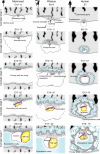Origin and function of the yolk sac in primate embryogenesis
- PMID: 32724077
- PMCID: PMC7387521
- DOI: 10.1038/s41467-020-17575-w
Origin and function of the yolk sac in primate embryogenesis
Abstract
Human embryogenesis is hallmarked by two phases of yolk sac development. The primate hypoblast gives rise to a transient primary yolk sac, which is rapidly superseded by a secondary yolk sac during gastrulation. Moreover, primate embryos form extraembryonic mesoderm prior to gastrulation, in contrast to mouse. The function of the primary yolk sac and the origin of extraembryonic mesoderm remain unclear. Here, we hypothesise that the hypoblast-derived primary yolk sac serves as a source for early extraembryonic mesoderm, which is supplemented with mesoderm from the gastrulating embryo. We discuss the intricate relationship between the yolk sac and the primate embryo and highlight the pivotal role of the yolk sac as a multifunctional hub for haematopoiesis, germ cell development and nutritional supply.
Conflict of interest statement
The authors declare no competing interests.
Figures






References
-
- Ravi, V. & Venkatesh, B. The divergent genomes of teleosts. Annu. Rev. Anim. Biosci. 6, 47–68 (2018). - PubMed
-
- Jeffery, J. E., Bininda-Emonds, O. R. P., Coates, M. I. & Richardson, M. K. Analyzing evolutionary patterns in amniote embryonic development. Evol. Dev. 4, 292–302 (2002). - PubMed
-
- Bainbridge, D. R. J. The evolution of pregnancy. Early Hum. Dev. 90, 741–745 (2014). - PubMed
-
- Blackburn, D. G. in Encyclopedia of Reproduction, Vol. 4 (eds Knobil, E. & Neill, J. D.) 994–1003 (Academic, London, 1999).
Publication types
MeSH terms
Grants and funding
LinkOut - more resources
Full Text Sources
Other Literature Sources

